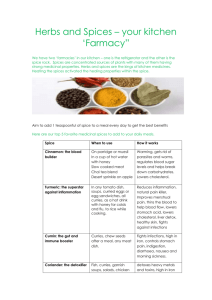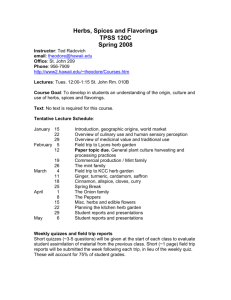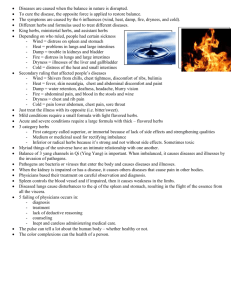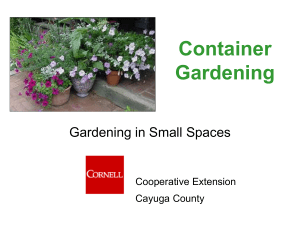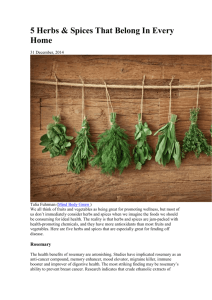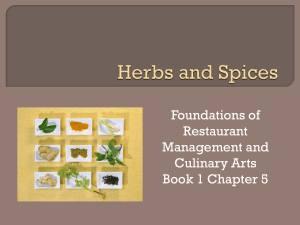Herbs and Spices Biology 355 Plants and People
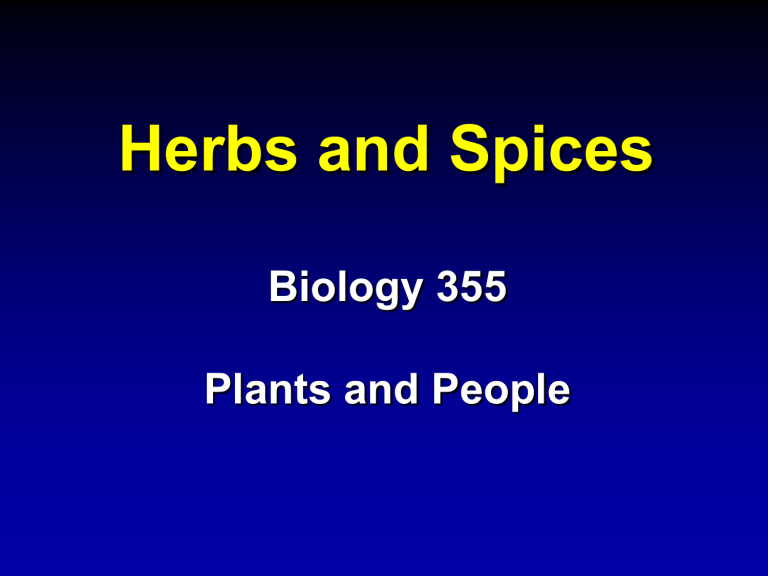
Herbs and Spices
Biology 355
Plants and People
Herbs and Spices
Robert S. Wallace
Dept. of Ecology, Evolution and
Organismal Biology
Iowa State University
“Herbs” versus “Spices”
•
There are several differences in definitions of ‘herbs’ versus ‘spices’.
•
Some suggestion that herbs come from the herbaceous
(non-woody) parts of plants (e.g. leaves).
•
Many spices come from reproductive plant parts (e.g. flowers, fruits, seeds), regardless of the place of geographic origin.
•
Some definitions are based on the geographic origins of the materials used:
•
Herbs tend to come from temperate regions.
•
Spices tend to come from tropical regions
•
Some definitions use ‘herb’ as a plant product which has applications beyond flavoring food (i.e. ‘medicinal herbs’ or
‘aromatic herbs’
•
No practical distinction, since they are traded internationally under their common names.
Working Definitions
•
Herb
– Primarily vegetative plant parts used for medicinal, aromatic, or savory purposes.
•
Spice – Primarily reproductive plant parts used for aromatic, or savory purposes.
•
Flavoring – Extracts of herbs, spices, or non-botanical products, used for savory purposes, but containing no actual plant parts.
Herbs and Spices
Throughout History
•
Highly prized and widely traded commodities.
•
Often used plant materials in lieu of currency – universally-used and desired.
•
Used to enhance the flavor of food, serve as medicines, provide pleasing aromas, and to enable ceremonial cremation or embalming of the dead. In some cases linked to religions.
•
Ancient trade routes (on land and sea) determined based upon locations of the sources of herbs and spices. Trade for these same commodities still occurs along these same paths today.
•
Much exploration and colonial establishment done to secure spices (e.g. Great Britain in India and in many islands).
•
Spice trade formed the basis of the economies of many small or developing nations.
•
Profound influence on changes in cuisine based upon mixing of cultures and sharing of tastes and flavors from around the
World.
Chemistry of Flavor
•
Flavor incorporates both aroma and taste.
•
Aromatic components must be volatile and capable of being perceived by humans’ olfactory senses.
•
Taste components must be at least partially soluble in water, and capable of stimulating humans’ taste buds.
•
Combination of senses required for full savory experience.
Chemical Compounds of
Herbs and Spices
•
“Essential Oils” – Often are complex mixtures of terpenes, and other terpenoid compounds.
-
Some are volatile and vaporize quickly.
-
Others remain as liquid oils and are perceived through both smell and taste senses.
These account for most ‘aromatic’ properties.
•
Esters – “fruity” aromas, often associated with ripening.
•
Amides - Nitrogen containing compounds, e.g. capsaicin.
•
Vitamins - Typically vitamins A, B-complex, and C.
Herbs and Spices of the Mint Family
(Lamiaceae)
•
Primarily from the Mediterranean region, Africa and
Asia
•
In almost all cases, leaves are the preferred plant part used.
•
Most species used for herbs have oil glands or secretory trichomes (epidermal hairs).
•
Contains a diverse array of terpenes in the essential oil component of the plant’s secondary metabolites.
- Peppermint – Mentha piperita
- Spearmint – Mentha spicata
- Basil – Ocimum basilicum
- Marjoram
– Origanum majorana
- Oregano – Origanum vulgare
- Rosemary – Rosmarinus officinalis
- Thyme – Thymus vulgaris
- Sage – Salvia officinalis
- Lavender
– Lavandula angustifolia
Plant Terpenes
Plant Terpenes
Vanillin
Peppermint
Spearmint
Basil
Oregano
Thyme
Rosemary
Herbs and Spices of the Carrot Family (Apiaceae)
•
Regions of origin are the Mediterranean and other places with temperate climates.
•
Leaves, stems, fruits and seeds are used.
•
Plant parts are used fresh, or they are dried.
•
Contain glands with an array of essential oils and terpenes.
•
Leaves and Stems:
- Chervil – Anthriscus cerefolium
- Cilantro – Coriandrum sativum*
Dill ‘weed’ – Anethum graveolens*
- Parsley – Petroselinum crispum
•
Fruits and ‘Seeds’ (actually mericarps):
- Anise – Pimpinella anisum
- Caraway – Carum carvi
- Celery – Apium graveolens
- Coriander – Coriandrum sativum*
- Cumin – Cuminum cyminum
Dill ‘seed’ – Anethum graveolens*
- Fennel – Foeniculum vulgare
* Same species (different cultivars) used for both leaves and fruits.
Caraway
Parsley
Dill
Cilantro and Coriander
‘Pepper’
•
Species used is Piper nigrum (Family Piperaceae)
•
Region of origin is India and Sri Lanka; presently grown in tropical regions, particularly Brazil, India, and Indonesia.
•
Plant part used is the fruit; a drupe.
•
Harvest and Preparation:
Black Pepper – Unripe but mature drupes removed from vines; piled in heaps in full sun to initiate enzymatic fermentation to darken fruits and develop flavor. When completed, fruits are dried fully in the sun and packaged for shipment.
White Pepper – Ripe and fleshy drupes are harvested and placed in running water for 1 to 2 weeks to rot away the fleshy parts of the pericarp, leaving the white endocarp and seed within. Remaining parts dried and packaged.
Green Pepper – Drupes harvested with green and pickled in brine or vinegar; the whole drupes are then dried.
Black Pepper
Black Pepper
“Peppers”
•
Primary species is Capsicum anuum (C. fructescens in
Tabasco sauce) [Family Solanaceae; the Potato Family]
•
Region of origin is South and/or Central America; grown commercially in tropical or warm temperate regions throughout the World.
•
Plant part used is the fruit (berry) and the seeds within.
•
Harvest and Preparation:
- Fruits grown to maturity, harvested, and used either fresh or quickly dried.
•
Compound that produces the “fire” is capsaicin , an amide with a chemical structure similar to vanillin, which stimulates pain receptors.
•
The ‘Hotness Scale’ is measured in Scoville Units:
A green ‘bell’ pepper is 0 S.U.; a jalapeno 2,500 – 3,000 S.U., and a habanero is ca. 300,000 S.U.
•
Capsaicin is useful when blocking pain in treating arthritis, shingles, diabetes, and neuralgia, or during surgery. High concentrations can be dangerous, causing blistering or redness of the skin, or cause temporary blindness in the eyes.
•
“Pepper Spray” used as a personal defense is a solution of capsaicin designed to disable an attacker without causing permanent damage.
Peppers
Peppers
Peppers
The Scoville Hotness Scale
Capsaicin – An amide
Capsaicin Products
Mustards
•
Species used are Brassica nigra and B. alba/B. hirta for seeds; Armoracia rusticana for roots (Family Brassicacae)
•
Region of origin is the Mediterranean; grown commercially throughout the world.
•
Plant parts used are the seeds to produce true mustards; the taproot of Armoracia rusticana is used to make horseradish.
•
Harvest and Preparation:
- For mustards, mature seeds are harvested and ground into a paste, to which additional flavorings are added.
- For horseradish, the taproot is harvested, washed, and ground.
•
Sulfur-containing compounds give mustards their characteristic flavor. The smell and taste of horseradish is derived from a glycoside sinigrin, which decomposes in the presence of water to form mustard oils.
Mustards
Horseradish
Ginger
•
Primary species used is Zingiber officinale
(Family Zingiberaceae)
•
Region of origin is tropical Asia; primary commercial growing regions are eastern and southern Asia, and pacific islands.
•
Plant part used is the rhizome (root-like underground stem), used either fresh or dried.
•
Harvest and Preparation:
- Plants grown to maturity
- Aboveground plant parts removed; rhizomes dug, washed, and prepared for use.
•
Related herb is Turmeric (Cucuma domestica)
[Zingiberaceae] from Asia, where dried rhizomes are used in curry powder, or as a source of soluble yellow dye.
Ginger
Garlic
•
Species used is Allium sativum (Family Alliaceae; the
Onion Family).
•
Region of origin is temperate central Asia; grown commercially throughout the world.
•
Plant parts used are the swollen leaf bases of the branching, subterranean corm. Used either fresh or dried, as individual ‘cloves’.
•
Harvest and Preparation:
- Plants grown to maturity, but harvested prior to the production of flowers.
- Corms harvested, washed, and stored cool and dry.
•
Garlic (and other cultivated members of the Alliaceae) have extensive medicinal properties. Demonstrated to be a stimulant of human immune response.
Garlic
Cloves
•
Species used is Syzygium aromaticum (Family Myrtaceae).
•
Region of origin is the “Spice Islands’ (Mollucas) and nearby areas of Indonesia. Now grown on many eastern
Indian Ocean islands.
•
Plant part use is the unopened flower bud; used locally when fresh, or more commonly, dried for export.
•
Harvest and Preparation:
- Flower buds are harvested as they turn from green to pink.
- Buds are dried, cleaned, graded, and packaged.
•
Clove oil, obtained by extracting buds stems and leaves of
S. aromaticum is a source of eugenol, which is used in perfumery, soap manufacture, and dentistry.
Cloves
Saffron
•
Species used is Crocus sativus (Family Iridaceae, the Iris Family).
•
Region of origin is from the Mediterranean; primary commercial growing regions are in Spain and Portugal.
•
Plant parts used are the stigmas of the flowers (…only!!), used dried.
•
Harvest and Preparation:
- Flowers at anthesis are harvested and the stigmas are removed manually.
- One acre of saffron plants yields between 8 and 12 pounds (3.5 to
5.5 kg) of dried spice per year.
- Approximately 154,000 flowers are needed for each kilogram of dried spice (210,000 stigmas per pound).
•
Intense yellow, water soluble coloring and distinctive flavors make saffron a valuable and sought-after spice, despite its high cost.
•
Turmeric (Cucuma domestica) is sometimes used as a substitute for saffron, but cannot match the same qualities of color and subtle flavors..
Saffron
Saffron
Nutmeg and Mace
•
Species used is Myristica fragrans (Family Myristicaceae).
•
Region of origin is the “Spice Islands’ (Mollucas) and nearby areas of Indonesia. Now grown on many eastern Indian
Ocean islands.
•
Plants are dioecious (separate male and female trees) with plantations having primarily female trees (1 male per 10 female trees).
•
Plant parts used are the seed (nutmeg) and the aril (mace) which surrounds the seed. Both parts are used dry.
•
Harvest and Preparation:
- Ripe, dehiscent fruits (berry-like fruits) are removed from trees.
- Berries that are split are then cleaned of pericarp (fruit wall), leaving a seed covered with a fleshy, red aril (mace).
- The aril is separated from the seed, and both are then dried and readied for shipment
•
Nutmeg is hallucinogenic in moderate concentrations, and is toxic in high concentrations
Nutmeg and Mace
Vanilla
•
Species used are Vanilla planifolia and V. fragrans (Orchidaceae; The
Orchid Family.
•
Plant part used is the dried, ‘fermented’ fruit, an immature capsule (“pod” or “bean”).
•
The region of origin is Central or South America; primary commercial growing regions are in Madagascar, Mexico, and Central America.
•
Harvest and Preparation:
- Individual vanilla flowers are hand-pollinated.
- Fruits (capsules) are allowed to mature approx. 9 months on the vines.
- Nearly mature (still green) capsules are harvested by hand.
- Fruits are placed in full sun to raise temperature.
Warm fruits are wrapped in blankets and ‘sweatted’ in boxes for one to several days until fruits begin to turn brown.
The ‘sunning’ and ‘sweatting’ process repeated for 25 to 36 days.
- Once the color change is complete, the fruits are dried indoors for one month, then placed in boxes to condition for 2 to 3 months, until they are packaged for shipment.
•
‘Real Vanilla Extract’ is made by percolating alcohol over chopped pieces of processed vanilla. Must be extracted from actual vanilla plant material.
•
‘Imitation Vanilla’ or ‘Artificial Vanilla Extract’ is a mixture of synthetic chemicals. Lacks complexity and subtle aromas and flavors found in real vanilla products.
Vanilla
Health Benefits of Herbs and Spices
•
Some reported to be anti-microbial agents;
‘preservatives’.
•
Anti-oxidants – various phenolic compounds, vitamins, β-carotene, etc.
•
Stimulation of gastrointestinal function.
•
Relaxation of smooth muscles; calming effects.
•
Improvement of immune system function.
•
Vermifuge – eradication of intestinal parasites.
•
Source of vitamins (A, B-complex, C) and some trace elements.
Summary
•
Diverse plants from throughout the World provide a wide range of herbs and spices which humans have identified as beneficial and desirable for their use.
•
Chemical components in the plant tissues (or subsequently developed by processing) are responsible for contributions to aroma and taste.
•
Select herbs and spices are often ‘signature’ flavors of certain cuisines.
•
Price of herbs and spices is often more related to costs involving labor, rather than rarity or geographic origin of the plants.

